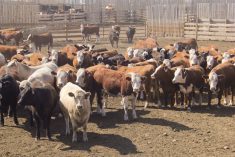U.S. live cattle futures fell to a two-and-a-half-month low on Wednesday in a broad-based selloff sparked by renewed concerns about the global economy that led to safe-haven investing in the dollar at the expense of other investments such as cattle, traders and analysts said.
"It’s a technical meltdown in cattle right now and a global meltdown. Slowing of the economies in Europe, China, Japan and the U.S. is causing a selloff of about everything, including cattle," said Dennis Smith, a broker for Archer Financial.
Read Also

U.S. livestock: Feeder cattle hit contract highs on tight supply
Chicago | Reuters – All Chicago Mercantile Exchange feeder cattle futures and most live cattle futures hit contract highs on…
"Cash is weakening too. Kansas cash cattle traded at $123, down $3 from last week," Smith said.
Declines were slowed by short covering and bargain buying following Tuesday’s two per cent slump, the biggest one-day tumble on a percentage basis in three and a half months.
Falling corn prices, signifying cheaper feed costs, encouraged buying of live cattle, feeder cattle and hog futures, the traders said, which helped limit the price slide of each.
Chicago Mercantile Exchange (CME) October cattle were down 0.39 per cent or 0.475 cents per pound at 122.225 cents/lb., and December was down 0.52 per cent or 0.65 cents at 124.75.
The average beef packer margin for Wednesday was a negative $38.50 per head, compared with a negative $37.15 on Tuesday and a negative $25.30 a week ago.
Choice beef at wholesale was priced at $192.70 per cwt, up two cents from Tuesday and select cuts were up 18 cents at $181.74, according to U.S. Department of Agriculture (USDA) estimates.
USDA reported the cattle slaughter on Wednesday at 120,000, down from 124,000 a week ago and down from 131,000 a year ago.
Feeder cattle rose, reversing six straight days of declines, as corn prices fell to a three-month low to spark increased investment in the young cattle destined for feedlots.
"Feeders broke yesterday and they’re about the only thing in the world in the green today and that’s because of corn. The corn market just keeps eroding," Smith said.
Feeders were seen as a potentially more profitable investment due to the easing feed costs following a U.S. summer drought that slashed corn production and boosted corn prices to record highs.
CME September feeders were up 0.17 per cent or 0.25 cents/lb. at 143.450 cents/lb., and October was up 0.64 per cent or 0.925 cents at 146.1.
"Corn is retreating so you’re starting to see better demand for feeders. We’re hearing reports of better corn yields and the government’s stock report on Friday could show more corn than expected," said Jack Salzsieder, analyst for K+S Financials.
The U.S. Department of Agriculture on Friday will release its quarterly stocks report. An average of analysts’ estimates pegged the U.S. corn supply on Sept. 1 at 1.113 billion bushels. The estimate was an eight-year low but still above previous outlooks due to the record early harvest of this year’s corn crop.
Salzsieder also said the lower feed prices should begin to slow cattle herd liquidation, leading to a more stable wholesale and retail beef market.
"Cattle numbers are already down. I think the liquidation phase should be slowing and wholesale beef should be starting to firm up," Salzsieder said.
Hog futures drop
Most CME hog futures contracts were lower on fund liquidation tied to the economic gloom with the exception of spot October which was up 0.79 per cent or 0.6 cents/lb. at 76.875 cents on short-covering. December hogs were down 0.37 per cent or 0.275 cents at 74.375.
"October hogs are up because of spreading and short-covering. Some people think the cash market will firm up because the demand is good but I’m not so sure about that. The supply is just too large, so that could keep pressure on the cash," Smith said.
Some position-squaring was noted ahead of USDA’s quarterly hogs and pigs report to be released at 2 p.m. CT on Friday.
An average of analysts’ estimates in a Reuters poll placed the number of hogs in the United States at 67.705 million, up 0.7 per cent from a year ago. However, the number kept for breeding were down 0.3 per cent from a year ago while the number kept for market were up 0.8 per cent.
Salzsieder said the hog market was beginning to find some fresh buying interest due to the declining feed costs as corn traded $1.25 per bushel, or 15 per cent, below its record high of $8.49 set on Aug. 10.
The October hog contract has risen nearly 10 per cent over the past three weeks as corn prices declined.
"As funds retreat from corn the next logical step is to buy feeders and other red meats," Salzsieder said.
HedgersEdge estimated the average pork packer margin for Wednesday at a positive $8.05 per head, compared with positive $6.20 on Tuesday and $16.15 a week ago.
USDA on Wednesday said wholesale skinned hams were firm with other cuts not established and trading was at a near standstill.
USDA reported the hog slaughter on Wednesday at 436,000 head, unchanged from a week ago and up from 426,000 a year ago.
— Sam Nelson writes for Reuters from Chicago. Additional reporting for Reuters by Theopolis Waters in Chicago.















